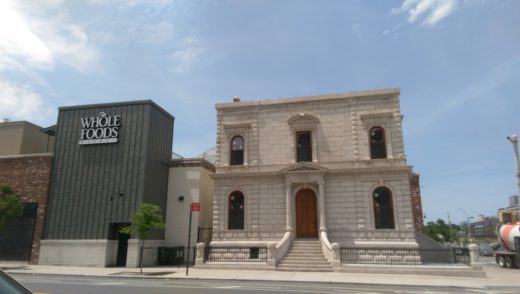
One way to get to know a neighborhood is by exploring its buildings. So we did that. This story is part of a series in The Brooklyn Ink on some of the structures in the borough, and what they tell us about the life in and around them.
The concrete and grand white building at 360 Third Ave. in Gowanus, Brooklyn, previously known as the Coignet Stone Company, was only recently restored to its original glory. The April restoration was paid for by Whole Foods, which built its store next to it, a modern companion to a 19th century structure.
Built in 1873, the home of Coignet Stone was a pioneering example of concrete construction, and the first known concrete building in New York City, according to research by the Landmark Preservation Committee. It was used as a showroom for the New York and Long Island Coignet Stone Company, the first U.S. company to manufacture artificial stone using techniques from the Frenchman, Francois Coignet. The company’s stone was used for construction.
For several decades after about the 1960s, the building was abandoned, after Coignet Stone closed and successor businesses also left. Some of those owners covered the concrete façade with red brick. The steps to the building crumbled over time, and the structure attracted graffiti. In 2005, Whole Foods petitioned the city to build a store at Third Ave. and Third St., which was accepted—on the condition that the company also restore the Coignet building.
In June 2006, the Landmark Preservation Committee designated the site as a landmark, writing that the building has “a special character, special historical and aesthetic interest and value as part of the development, heritage, and cultural characteristics of New York City.”
The building is two stories tall with identical facades on the sides that face Third Ave. and Third St. Brand new wooden doors are placed in the middle of each façade, and each has five windows that still bear the stickers that indicate they were newly installed. Stone steps lead up to each door. The one difference between the facades is that the steps to the door facing Third St. are raised an unusual height from street level. It would take some effort for even an adult to reach the bottom step.
Not everyone is a fan. Longtime residents James and Tonya McKenna recalled often driving by the Coignet building when it was still covered by red brick. Now that the structure has been restored, James said the building seems to have lost its “ghosts,” the history that gave it character. “I like the idea of having a doorknob that somebody could have turned back in the 1920s or something,” he said. “Now it looks brand new, like everything else around it.”
The building is on the market for $5 million and listed by Cushman & Wakefield, although you wouldn’t know it by walking by. There is no for sale sign or realtor sign from Cushman & Wakefield. For that matter there is no street number on the building.
To some, the architecture seems a bit odd next to the modern design of the Whole Foods, or across the street from the brick mid-century apartment building nearby, and the bright blue storage facility further down Third Ave. As a building that once stood on its own at the intersection, it has been restored to its original concrete façade, but its surroundings reflect almost 150 years of rapid change.


Leave a Reply